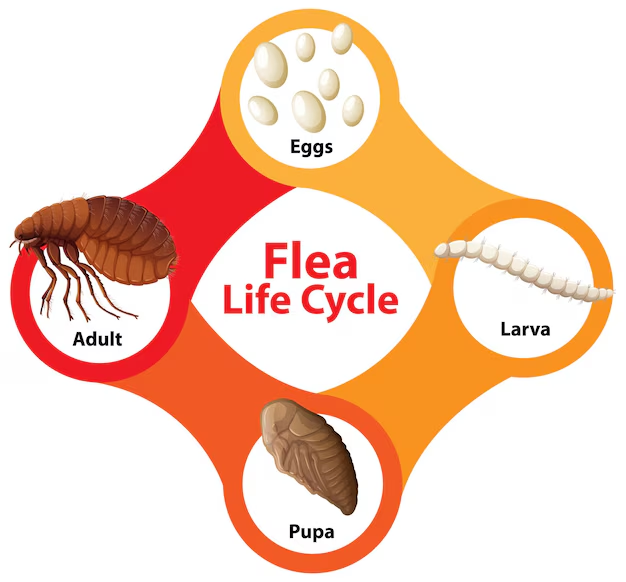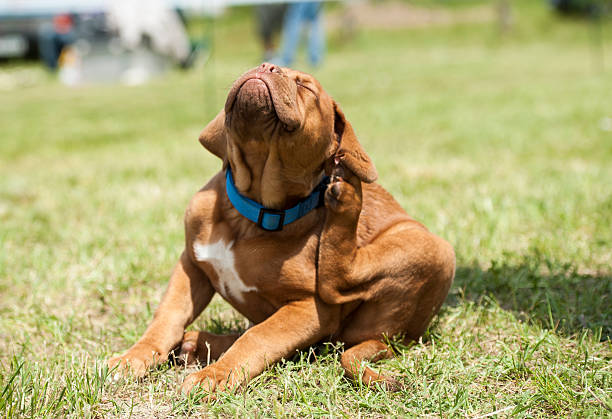What are fleas?
Fleas are tiny wingless parasites that stay alive by sucking on animal or human blood. They find new hosts to live on by searching for body heat, movements, and breathing. (Fleas can’t see well.) Once fleas sense a new host, they jump onto its skin, fur, or feathers. A couple of fleas on your dog will produce many more. After feeding on your dog’s blood, adult fleas will reproduce and lay eggs in its fur. After these eggs are laid, over half will fall off your dog as they move around. Once these eggs hatch into larvae, they find a place (for instance, a dog bed, couch, or threads in the carpet) to creep into and make a sack. In 2 – 3 weeks, they become adult fleas looking for hosts to jump onto, to consume blood, and to lay their own eggs. Parasite specialists have confirmed that there are over 2,500 species of fleas globally, and about 320 are in the United States.
Where do fleas come from?
The short and sweet answer is outside. They typically live in grass, shrubs, dens, burrows, and nests. Wild animals like racoons, foxes, and squirrels most likely have fleas, and your dog may be drawn to places where these animals live. Fleas prefer to be in warm and humid areas but will survive cold weather waiting for a host. A flea in any stage of growth will die in freezing temperatures. Fleas can remain inactive for a long time, waiting for the weather to warm up or the right host to pass by.
Flea life cycle
A flea life cycle takes between 2 weeks and 10 months, depending on the temperature, their access to food, and the breed of flea. They prefer a temperature of 65 F to 80 F and a humidity of 70%. There are four stages in the flea life cycle.
- Eggs. A female flea lays 15 to 40 eggs daily on the host’s fur. These eggs are white, smooth, and oval-shaped, about 0.5 mm long.
- Larvae. In 7to 14 days, the eggs hatch into larvae that look like petite clear worms. The larval stage can last 1 week to 3 months. Flea larvae eat dandruff and skin flakes, blood and feces delivered by adult fleas. The adult fleas poop out excess dried blood in tiny bits, called “flea dirt.” Eating flea dirt turns the larvae from a clear color to a dark brown. Flea larvae move quite fast and will live in floor cracks or under pet beds and carpets as they age.
- Pupae. Hidden from view, the larva spins a white silken cocoon and molts into a pupa. This may take 1 to 2 weeks, but fleas can remain as pupae for months if it’s winter weather.
- Adult fleas. Warm weather and the presence of a host will encourage fleas to emerge from their cocoons. A newly emerged flea can about a week without having a blood meal. Ideal conditions can allow a flea to live up to 18 months, but a more normal life cycle is 3 to 4 months.

How to get rid of fleas
4 tips for home flea treatment:
- Vacuum regularly the areas where your pet sleeps, sits, and eats, like floors, rugs, furniture, and pet beds. This will pick up fleas, flea dirt, larvae, and flea eggs. Throw out the contents of the vacuum or canister when you’re finished.
- Wash all pet bedding in hot water weekly and dry it in a hot dryer, if you can.
- Steam-clean and shampoo carpets, rugs, and furniture. If you notice fleas after doing this (they may hatch because of the warm water), keep vacuuming and cleaning until they’re gone.
- Spray the house with a preventive spray, in severe cases, use a flea bomb or room fogger. Remove family members, pets and plants from the affected area(s) when using insecticides and follow the label directions closely.
Once you’ve killed the fleas on your pet through medication and grooming, keep them from returning by thoroughly cleaning and vacuuming the areas where your pet lives and sleeps.
Flea prevention tips
The best way to deal with a flea problem is to prevent it. Quick tips to follow on flea prevention.
- Regularly give your pet a pill to prevent fleas. Your vet can help you pick the right one.
- Have your pets wear a flea collar. Check with your vet before combining a flea collar with flea medication.
- Completely vacuum areas where your pets live or sleep. Regular vacuuming can remove up to 95% of flea eggs, as well as some larvae, and adults.
- Groom your pets regularly.
- Remove debris and low-hanging trees and vegetation to reduce fleas. Cut tall grass.
- If your dog or cat goes outside, you’ll need to do some outdoor maintenance as well. Cover crawl spaces, areas under porches, and openings to basements, where pets and wild animals like to hide.
- Consider keeping your pets from roaming outdoors, where they’re more likely to encounter fleas.
Will fleas go away on their own?
No, fleas will not go away on their own. Fleas are extremely resilient and are the most common parasite that infest animals. Waiting for fleas to die off naturally will eventually lead to an extreme infestation of your pets and home. 40% of fleas carry disease and tapeworms, which can be transferred to humans and animals. The CDC reports that fleas transmit germs that cause disease primarily through the process of feeding on their host or through fecal contamination. Disease from fleas will also be transmitted when their feces come into contact with an open wound.
Artical resource credit Web MD & the CDC.




